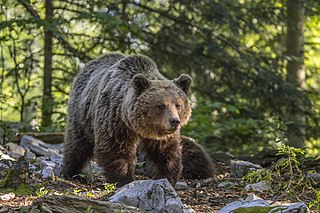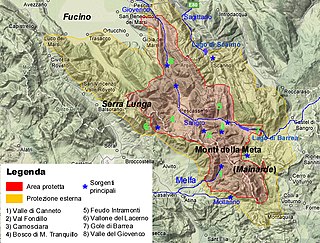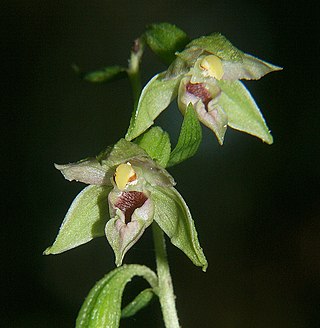
The European Environment Agency (EEA) is the agency of the European Union (EU) which provides independent information on the environment.

Abruzzo, historically known as Abruzzi, is a region of Southern Italy with an area of 10,763 square km and a population of 1.3 million. It is divided into four provinces: L'Aquila, Teramo, Pescara, and Chieti. Its western border lies 80 km (50 mi) east of Rome. Abruzzo borders the region of Marche to the north, Lazio to the west and north-west, Molise to the south and the Adriatic Sea to the east. Geographically, Abruzzo is divided into a mountainous area in the west, which includes the highest massifs of the Apennines, such as the Gran Sasso d'Italia and the Maiella, and a coastal area in the east with beaches on the Adriatic Sea.

Gran Sasso d'Italia is a massif in the Apennine Mountains of Italy. Its highest peak, Corno Grande, is the highest mountain in the Apennines, and the second-highest mountain in Italy outside the Alps. The mountain lies within Gran Sasso e Monti della Laga National Park.

The Eurasian brown bear is one of the most common subspecies of the brown bear, and is found in much of Eurasia. It is also called the European brown bear, common brown bear, common bear, and colloquially by many other names. The genetic diversity of present-day brown bears has been extensively studied over the years and appears to be geographically structured into five main clades based upon analysis of the mtDNA.

Abruzzo, Lazio and Molise National Park is an Italian national park established in 1923. The majority of the park is located in the Abruzzo region, with smaller parts in Lazio and Molise. It is sometimes called by its former name Abruzzo National Park. The park headquarters are in Pescasseroli in the Province of L'Aquila. The park's area is 496.80 km2 (191.82 sq mi).

Epipactis leptochila, the narrow-lipped helleborine, is a species of orchid in the genus Epipactis. Found in chalk or limestone-based beech and hornbeam woodland in southern England, the orchids are also found with birch and alder trees in Scotland and the north of England. The narrow-lipped helleborine blooms from early June to mid-August. Epipactis leptochila is also found in parts of northern Europe but it is known for its presence in England. Due to woodland clearing, the orchids are becoming less common.

Vipera ursinii is a species of venomous snake in the subfamily Viperinae of the family Viperidae. It is a very rare species, which is in danger of extinction. This species is commonly called the meadow viper. It is found in France, Italy, and Greece as well as much of eastern Europe. Several subspecies are recognized. Beyond the highly threatened European population, poorly known populations exist as far to the east as Kazakhstan and northwestern China.

Campo Imperatore is a mountain grassland or alpine meadow formed by a high basin shaped plateau located above Gran Sasso massif, the largest plateau of Apennine ridge. Known as "Little Tibet", it is located in Gran Sasso e Monti della Laga National Park, near L'Aquila, Abruzzo, Italy.

Beskydy Protected Landscape Area (PLA) is the largest PLA in the Czech Republic. The area is 1,160 km2 (450 sq mi).
Serratorotula coronata is a species of air-breathing land snail, terrestrial pulmonate gastropod mollusks in the family Geomitridae, the hairy snails and their allies.

Cordulegaster trinacriae is a species of dragonfly in the family Cordulegastridae. It is endemic to central-southern Italy, from Abruzzo south to Calabria and Sicily, from where it was first described. Its natural habitats are humid forests, rivers, and freshwater springs. It is threatened by habitat loss.

The Marsican brown bear, also known as the "Apennine brown bear", and orso bruno marsicano in Italian, is a critically endangered population of the Eurasian brown bear, with a range restricted to the Parco Nazionale d'Abruzzo, Lazio e Molise, and the surrounding region in Italy. The Marsican brown bear differs slightly from other brown bears in its appearance and hibernation techniques. The bear's popular name is derived from Marsica, a historic area of the modern-day region of Abruzzo where the bear has long had a significant presence.
Vaikkojoki River is a 50-kilometre (31 mi) long river, which is in provinces of Northern Karelia and Northern Savonia.
Coincya cintrana is a flowering plant of the family Brassicaceae. It is a hemicryptophyte plant, and it grows on walls, in steep areas and in rocky slopes. It flowers from April until June.

Nakskov Fjord is an inlet in the west of the island of Lolland, Denmark. It is about 12 km (7.5 mi) long. There are about 10 small islands located in the fjord. The largest town in the area is Nakskov. The area is a designated bird sanctuary.
The Common Database on Designated Areas or CDDA is a data bank for officially designated protected areas such as nature reserves, protected landscapes, national parks etc. in Europe.

Iris marsica is a plant species in the genus Iris, it is also in the subgenus Iris. It is a rhizomatous perennial, from the Apennine Mountains, in Italy. It has glaucous, sickle-shaped or curved, light green leaves, slender stem with 2 branches, and 3 violet, light blue violet, dark violet, and dark purple flowers. It was only found and described since 1973, and is not yet in general cultivation. It was once thought to be a form of Iris germanica, but has different morphological characteristics and different chromosomal differences.

Campanula alpestris, the alpine bellflower, is a species of flowering plant in the family Campanulaceae. It is native to the southwestern European Alps.

Salix repens, the creeping willow, is a small, shrubby species of willow in the family Salicaceae, growing up to 1.5 metres in height. Found amongst sand dunes and heathlands, it is a polymorphic species, with a wide range of variants. In the UK, at least, these range from small, prostrate, hairless plants at one end of the spectrum to taller, erect or ascending silky-leaved shrubs at the other. This wide variation in form has resulted in numerous synonyms.

Topo Islet is a vegetated uninhabited islet just off the extreme southeastern tip of the island of São Jorge in the Portuguese archipelago of the Azores.















